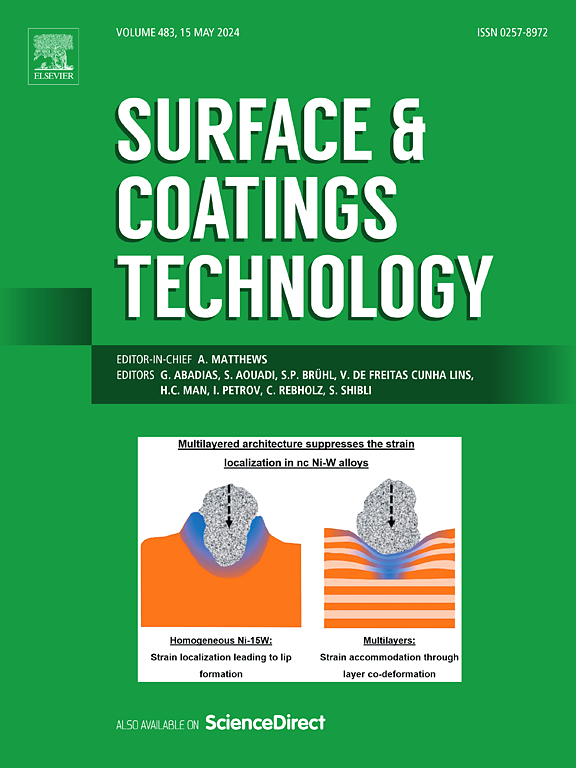Microstructures and interface analysis of Y doped Li7La3Zr2O12 solid electrolyte coatings by colloidal coating process for the application of all solid-state lithium ion batteries
IF 5.3
2区 材料科学
Q1 MATERIALS SCIENCE, COATINGS & FILMS
引用次数: 0
Abstract
The concept of all solid-state lithium ion battery (ASSLIB) compared with that of the current liquid electrolyte lithium ion batteries are more safety and with higher power densities. One of the key components of ASSLIB is the solid electrolyte. The study is attempt to investigate the microstructures of Y doped Li7La3Zr2O12 (Y-LLZO) solid electrolyte coatings and the interfaces between the solid electrolyte and LiCoO2 (LCO) electrode of ASSLIB. The preparation of the Y-LLZO coatings are by a colloidal coating process via the spin coating method. And the Y-LLZO powders are synthesized by a solid-state reaction method. The as-prepared Y-LLZO powders after calcined at 900 °C for 12 h show the crystalline phase of cubic garnet. The dense Y-LLZO coating layers with the thickness around several microns deposited on the LCO substrate can be obtained after sintered at 1100 °C for 12 h. The EDS element mapping results show that three types of regions can be classified from the microstructures, including the (Co,O)-rich, (Co, La, O)-rich, and (La, Y, Zr, O)-rich regions near the interface of the Y-LLZO coatings and the LCO substrate. The (Co,O)-rich should be from the initial LCO grains, and the (La, Y, Zr, O)-rich regions should be from the initial Y-LLZO grains. And the (Co, La, O)-rich regions is possible due to the inter-diffusion of La and Co elements from Y-LLZO and LCO, respectively. The formation of the (Co, La, O)-rich regions is most possibly LaCoO3 grains. Due to the over-diffusion and the formation of secondary phase between Y-LLZO solid-electrolyte coating layer and LCO cathode electrode substrate after sintered at 1100 °C for 12 h. It is suggested that the process temperature for the LLZO-based electrolyte should be <1100 °C.
应用于全固态锂离子电池的Y掺杂Li7La3Zr2O12固体电解质涂层的微观结构和界面分析
全固态锂离子电池(ASSLIB)的概念与目前液态电解质的锂离子电池相比,安全性更高,功率密度更高。固体电解质是ASSLIB的关键组成部分之一。本研究试图研究Y掺杂Li7La3Zr2O12 (Y- llzo)固体电解质涂层的微观结构以及固体电解质与ASSLIB的LiCoO2 (LCO)电极之间的界面。Y-LLZO涂层的制备采用自旋涂覆胶态工艺。采用固相反应法制备了Y-LLZO粉体。制备的Y-LLZO粉体在900℃煅烧12 h后,呈立方石榴石晶相。在1100℃烧结12 h后,在LCO基体上沉积了厚度约为几微米的致密的Y- llzo涂层。能谱元素映射结果表明,Y- llzo涂层与LCO基体交界面附近的微观结构可分为富(Co,O)区、富(Co, La, O)区和富(La, Y, Zr, O)区三种类型。富(Co,O)区应来自初始LCO晶粒,富(La, Y, Zr, O)区应来自初始Y- llzo晶粒。而(Co, La, O)富集区可能是由于La和Co元素分别从Y-LLZO和LCO中相互扩散而形成的。富(Co, La, O)区的形成极有可能是LaCoO3颗粒。在1100℃烧结12 h后,由于Y-LLZO固体电解质涂层与LCO阴极电极衬底之间存在过扩散和二次相的形成,建议将llzo基电解质的工艺温度控制在1100℃。
本文章由计算机程序翻译,如有差异,请以英文原文为准。
求助全文
约1分钟内获得全文
求助全文
来源期刊

Surface & Coatings Technology
工程技术-材料科学:膜
CiteScore
10.00
自引率
11.10%
发文量
921
审稿时长
19 days
期刊介绍:
Surface and Coatings Technology is an international archival journal publishing scientific papers on significant developments in surface and interface engineering to modify and improve the surface properties of materials for protection in demanding contact conditions or aggressive environments, or for enhanced functional performance. Contributions range from original scientific articles concerned with fundamental and applied aspects of research or direct applications of metallic, inorganic, organic and composite coatings, to invited reviews of current technology in specific areas. Papers submitted to this journal are expected to be in line with the following aspects in processes, and properties/performance:
A. Processes: Physical and chemical vapour deposition techniques, thermal and plasma spraying, surface modification by directed energy techniques such as ion, electron and laser beams, thermo-chemical treatment, wet chemical and electrochemical processes such as plating, sol-gel coating, anodization, plasma electrolytic oxidation, etc., but excluding painting.
B. Properties/performance: friction performance, wear resistance (e.g., abrasion, erosion, fretting, etc), corrosion and oxidation resistance, thermal protection, diffusion resistance, hydrophilicity/hydrophobicity, and properties relevant to smart materials behaviour and enhanced multifunctional performance for environmental, energy and medical applications, but excluding device aspects.
 求助内容:
求助内容: 应助结果提醒方式:
应助结果提醒方式:


